Here's a "quickie" drawing of the hood and the tank. The idea for me was to get as much good light into a standard (read: free on Craigslist) aquarium. There aren't any dimensions on the drawing because every aquarium is a little different. My main piece of advice along those lines would be to wait until you actually have the aquarium to start building the light hood. My light hood is a little oversized, and I have a problem with everything drying out a little too quickly, necessitating more watering than I really want to do.
I plan on modifying the design a little now that I've had it for a while. I'm going to add some aluminum angle to the back of the aquarium, which will seal up the long gap there. The weather stripping didn't hold very well with the constant sliding back and forth of the hood.
Hope this is useful! I'd be glad to write up measurements sometime if anyone thinks it would help, but I would emphasize that every aquarium varies from the others!
This picture shows the air movement fan. It runs continuously, blowing up against the plexiglass. It moves air in the entire tank.
When I first built it, I laid out the bottom with a single layer of styrofoam, then I took several styrofoam balls (green florist's foam) and cut them in half. I attached them to the foam sheet with black silicone and bamboo skewers. The balls suggest hills in the tiny landscape - I think they're a nice touch....
Then I covered the whole mess with black silicone and sprinkled it with coir (as suggested by Black Jungle). What I've been noticing is that the styrofoam half-spheres are coming loose from the sheet. This wouldn't be a problem if I weren't constantly moving plants around. Since the wires that I have the mounts supported on are not stainless steel (I use stiff floral stem wire), they rust on the end that's in the foam, and they resist being pulled out. I'm not sure what I would change in future iterations, but I would probably use more bamboo skewers to keep the half-spheres in place.
I grow in a 30 gallon aquarium. I use 4 60W equivalent compact fluorescent bulbs to light it. They are in a wooden hood that I built for the terrarium. The bottom of the hood is plexiglass, so any heat coming off the bulbs doesn't enter the tank. I have a fan at one end of the hood and holes drilled at the other to keep heat from building up inside it.
Inside the tank, I have a computer fan that blows upward onto the plexiglass to move air around. I run a Repti-fogger on a timer - 3 hours early in the morning, then a couple of times a day for 15 minutes. I use RO water in the fogger to prevent any problems with the mechanism.
I haven't needed to do any active cooling - the terrarium is in my basement, the lights are above plexiglass, and I use clay pots or mounts to keep the plants' roots cool.
I give the plants the appropriate light by mounting them on wires. I stick the wires into styrofoam at the base of the terrarium. I have a layer of coconut husk fiber (coir) covered with live moss over the styrofoam, so it's relatively attractive.
 This picture shows the inside of the hood. There are light bulbs in there, but they're bright enough that you can't see them individually. The inside of the hood is lined with reflective mylar. The base of the hood is clear plexiglass to minimize the transfer of heat into the terrarium. There is also a venting fan at one end of the hood and a series of holes at the other end to keep heat from building up inside the hood.
This picture shows the inside of the hood. There are light bulbs in there, but they're bright enough that you can't see them individually. The inside of the hood is lined with reflective mylar. The base of the hood is clear plexiglass to minimize the transfer of heat into the terrarium. There is also a venting fan at one end of the hood and a series of holes at the other end to keep heat from building up inside the hood.Here's a picture showing what it looks like most of the time. I have a fabric curtain hanging in front of the mechanics. It's a nice display, overall.
This picture shows the workings. There is a Repti-Fogger that I use to humidify the tank. It's on a timer - 3 hours in the morning and 15 minutes a few times during the day. The lights are on a timer, as well.
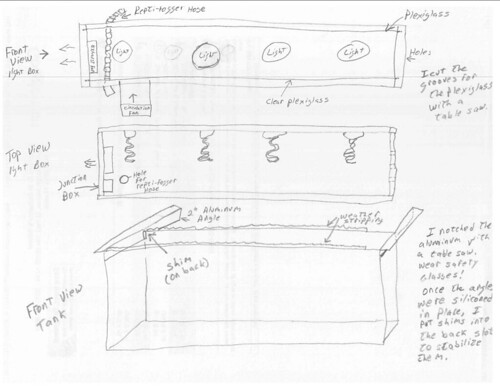
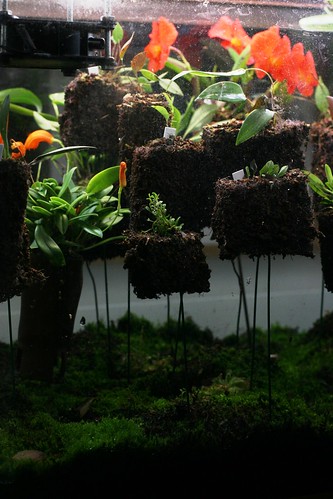
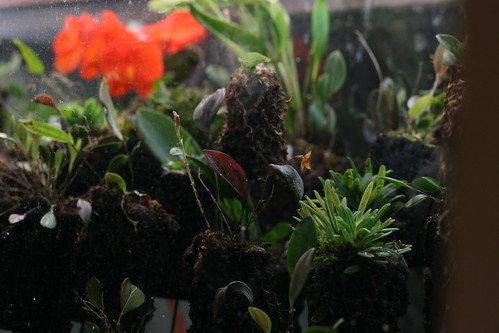
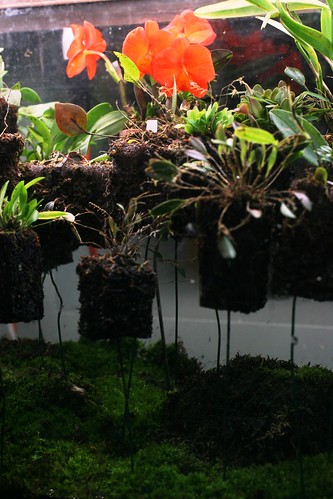

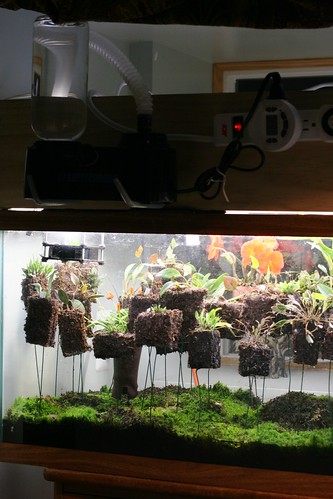
What you keep temperatures in the middle?
ReplyDelete70-75 degrees Fahrenheit.
ReplyDeleteIncredible!!!
ReplyDelete